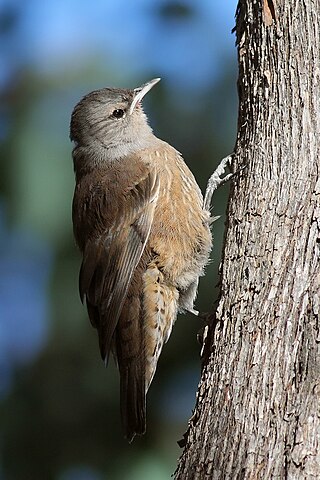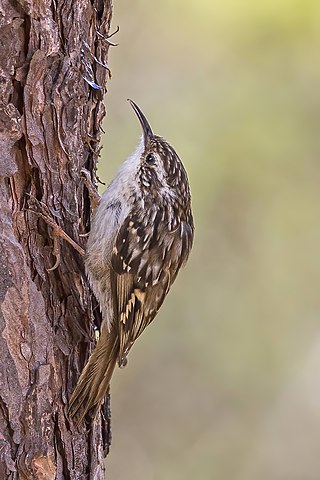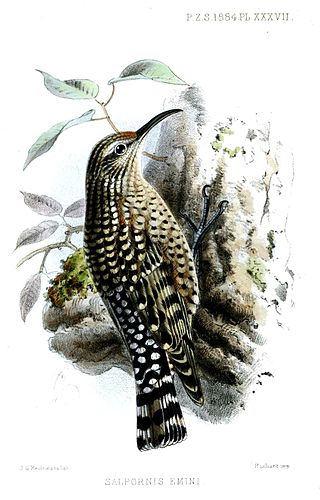
The nuthatches constitute a genus, Sitta, of small passerine birds belonging to the family Sittidae. Characterised by large heads, short tails, and powerful bills and feet, nuthatches advertise their territory using loud, simple songs. Most species exhibit grey or bluish upperparts and a black eye stripe.

The Indian spotted creeper is a small passerine bird, which is a member of the subfamily Salpornithinae which is placed along with the treecreepers in the family Certhiidae. This small bird has a marbled black and white plumage that makes it difficult to spot as it forages on the trunks of dark, deeply fissured trees where it picks out insect prey using its curved bill. It is found in patchily distributed localities mainly in the dry scrub and open deciduous forests of northern and central peninsular India. It does not migrate. Their inclusion along with the treecreepers is not certain and some studies find them more closely related to the nuthatches while others suggest a close relation to the wallcreeper. They lack the stiff tail feathers of treecreepers and do not use their tail for supporting them while creeping vertically along tree trunks.

There are seven species of Australasian treecreeper in the passerine bird family Climacteridae. They are medium-small, mostly brown birds with patterning on their underparts, and all are endemic to Australia-New Guinea. They resemble, but are not closely related to, the Holarctic treecreepers. The family is one of several families identified by DNA–DNA hybridisation studies to be part of the Australo-Papuan songbird radiation. There is some molecular support for suggesting that their closest relatives are the large lyrebirds.

The Eurasian treecreeper or common treecreeper is a small passerine bird also known in the British Isles, where it is the only living member of its genus, simply as treecreeper. It is similar to other treecreepers, and has a curved bill, patterned brown upperparts, whitish underparts, and long stiff tail feathers which help it creep up tree trunks. It can be most easily distinguished from the similar short-toed treecreeper, which shares much of its European range, by its different song.

The short-toed treecreeper is a small passerine bird found in woodlands through much of the warmer regions of Europe and into north Africa. It has a generally more southerly distribution than the other European treecreeper species, the common treecreeper, with which it is easily confused where they both occur. The short-toed treecreeper tends to prefer deciduous trees and lower altitudes than its relative in these overlap areas. Although mainly sedentary, vagrants have occurred outside the breeding range.

The brown creeper, also known as the American treecreeper, is a small songbird, the only North American member of the treecreeper family Certhiidae.

The white-throated treecreeper is an Australian treecreeper found in the forests of eastern Australia. It is unrelated to the northern hemisphere treecreepers. It is a small passerine bird with predominantly brown and white plumage and measuring some 15 cm (6 in) long on average. It is insectivorous, eating mainly ants. Unlike treecreepers of the genus Climacteris, the white-throated treecreeper does not engage in cooperative breeding, and wherever it overlaps with species of that genus, it feeds upon much looser bark besides typically using different trees.

The Sichuan treecreeper is a rare species of bird in the treecreeper family, Certhiidae.

Climacteris is a genus of bird in the family Climacteridae. These birds and the other members of the family, genus Cormobates, are similar to Northern Hemisphere creepers, Certhiidae, in climbing helically up tree trunks looking for insect food. Differences from Cormobates are

The Daurian starling, or purple-backed starling, is a species of bird in the starling family found in the eastern Palearctic from eastern Mongolia and southeastern Russia to North Korea and central China.

The Sikkim treecreeper is a species of bird in the treecreeper family.

The bar-tailed treecreeper, or the Himalayan treecreeper is a species of bird in the family Certhiidae. It is found primarily in the northern parts of the Indian subcontinent, particularly in the Himalayas, as well as in adjoining regions. It is found in Afghanistan, India, Iran, Kazakhstan, Myanmar, Nepal, Tibet, Russia, Tajikistan, Turkmenistan, and Uzbekistan. Its natural habitats are boreal forests and temperate forests.

The rusty-flanked treecreeper or the Nepal treecreeper is a species of bird in the family Certhiidae. It is found in northern India, Nepal, Bhutan and western Yunnan. Its natural habitats are boreal forests and temperate forests.

The white-browed treecreeper is the smallest of the Australo-papuan treecreepers and sole family member adapted to arid environments. The species foraging strategy involves climbing the trunks of trees in search of invertebrate prey on and under bark. Although some populations within the species range have declined, the species IUCN conservation status is of Least Concern.

The rufous treecreeper is a species of bird in the family Climacteridae. It is endemic to Australia.

Cormobates is a genus of bird in the Australasian treecreeper family. Its scientific name means ‘trunk-creeper’, from the Greek cormos and bates.

The banded yellow robin or olive-yellow robin is a species of bird in the Australasian robin family Petroicidae that is found in New Guinea. It is the only species in the genus Gennaeodryas. Its natural habitats are subtropical or tropical moist lowland forest and subtropical or tropical moist montane forest. It is threatened by habitat loss. It has a high mortality rate due to its inability to traverse across a matrix.

Hodgson's treecreeper is a small passerine bird from the southern rim of the Himalayas. Its specific distinctness from the common treecreeper was recently validated.

Hume's treecreeper was earlier included within the brown-throated treecreeper complex and identified as a separate species on the basis of their distinctive calls. This species in the treecreeper family is found in Assam, Myanmar, Shan Mountains, Northern Thailand, Laos and the Dalat Plateau.

The African spotted creeper is a small passerine bird, which is a member of the subfamily Salpornithinae of the treecreeper family Certhiidae. It is found in sub-Saharan Africa in open deciduous forest and mango groves. It does not migrate other than local movements.





















